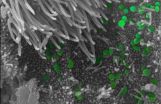INFORMATION:
The study was supported by the National Institute of Allergy and Infectious Diseases and the Defense Threat Reduction Agency. The article can be found online at [URL to come].
mBio® is an open access online journal published by the American Society for Microbiology to make microbiology research broadly accessible. The focus of the journal is on rapid publication of cutting-edge research spanning the entire spectrum of microbiology and related fields. It can be found online at http://mbio.asm.org.
The American Society for Microbiology is the largest single life science society, composed of over 39,000 scientists and health professionals. ASM's mission is to advance the microbiological sciences as a vehicle for understanding life processes and to apply and communicate this knowledge for the improvement of health and environmental and economic well-being worldwide.
Some flu viruses potentially more dangerous than others
2014-11-18
(Press-News.org) WASHINGTON, DC - November 18, 2014 - Certain subtypes of avian influenza viruses have the potential to cause more severe disease in humans than other avian influenza subtypes and should be monitored carefully to prevent spread of disease, according to a study published this week in mBio®, the online open-access journal of the American Society for Microbiology.
The work, directed by researchers at the National Institute of Allergy and Infectious Diseases in Bethesda, Md., found that flu viruses expressing the low pathogenicity avian H1, H6, H7, H10 or H15 hemagglutinins (genes that encode the major surface protein for the virus) led to fatal infections in mice and caused more cell damage in normal human lung cells grown in culture as compared to avian influenza viruses with other subtypes. The 1918 H1 subtype hemagglutinin has been already identified as a key virulence factor in the pandemic influenza virus of 1918. That virus, which caused the so-called "Spanish flu," spread rapidly around the world, resulting in approximately 50 million deaths.
"Viruses with these avian hemagglutinins have some type of inherent virulence motif to them, in that they induce a marked inflammatory response in mammals including human cells in culture," said senior study author Jeffery K. Taubenberger, MD, PhD, chief of the Viral Pathogenesis and Evolution Section of NIAID's Laboratory of Infectious Diseases. In 2013-2014 there have been close to 400 cases of avian influenza H7N9 infections in people in China, many severe, along with small numbers of severe human infections with H10N8 and H6N1 subtypes. "From a public health and epidemiology standpoint, it's useful to know that avian viruses of these subtypes (for example, H6, H7, or H10) might lead to more severe infections in humans and is something to look out for."
In a specialized laboratory , Taubenberger and colleagues developed a series of viruses mimicking 13 subtypes of contemporary low pathogenicity avian influenza A viruses. Each avian influenza virus tested was genetically identical to each other except that they expressed different hemagglutinin subtypes. After growing the viruses in culture, the researchers inoculated them into mice and watched to see what would happen. This approach allowed a direct comparison of the role of different hemagglutinins in virulence.
The viruses expressing the H1, H6, H7, H10 and H15 subtypes all caused rapid weight loss and fatal pneumonia infections within a week. By contrast, the H2, H3, H5, H9, H11, H13, H14 and H16-expressing viruses caused only mild weight loss but no significant disease.
The research team performed a similar test using hemagglutinins from two 2013 H7N9 flu viruses from outbreaks in Anhui and Shanghai, China, with similar results in mice. They also took a subset of these viruses and put them in culture with normal human lung cells that line the airways. The cells had developed into a thick layer called an epithelium. The disease-causing viruses like H1 and H7 caused mature cells to rapidly die over a couple of days, leaving just a thin lining behind.
These results suggest that hemagglutinins may not require immune cells to trigger cell damage but instead may cause programmed cell death or other molecular processes that could ultimately lead to enhanced disease or fatalities, Taubenberger said. In the future it will be important to tease out the differences in the hemagglutinins' structural features and investigate the molecular processes involved as the viruses infect mammalian cells, he said.
Meanwhile, until more is understood about how flu viruses cross from animals to humans and spread, more research is needed into producing a more broadly protective "universal" flu vaccine that may ultimately offer the best protection against future pandemics, he said.
ELSE PRESS RELEASES FROM THIS DATE:
Combined strategies help patients with adverse heparin reaction before heart surgery
2014-11-18
(WASHINGTON, November 18, 2014) - New evidence suggests that therapeutic plasma exchange and appropriate blood testing could help patients who are in urgent need of heart surgery, but have a history of an adverse reaction to the blood thinner heparin, according to a study, published online today in Blood, the Journal of the American Society of Hematology (ASH).
Many patients who take blood thinners will eventually require some form of heart surgery, which requires the administration of large quantities of heparin to prevent clots. Some patients who have taken heparin ...
Going against the flow
2014-11-18
Mycoplasma gallisepticum causes chronic respiratory disease in birds. The illness particularly affects domestic chicken and turkey flocks. The bacteria are especially life-threatening for the animals when they occur in combination with other infections. In order to control the spread of the disease, poultry farms in the EU must be proven free from Mycoplasma gallisepticum or face being closed.
Mycoplasma gallisepticum is related to the human pathogen Mycoplasma pneumoniae, the causative agent of human bronchitis and pneumonia. Mycoplasmas are among the world's smallest ...
Gravity may have saved the universe after the Big Bang, say researchers
2014-11-18
New research by a team of European physicists could explain why the universe did not collapse immediately after the Big Bang.
Studies of the Higgs particle - discovered at CERN in 2012 and responsible for giving mass to all particles - have suggested that the production of Higgs particles during the accelerating expansion of the very early universe (inflation) should have led to instability and collapse.
Scientists have been trying to find out why this didn't happen, leading to theories that there must be some new physics that will help explain the origins of the universe ...
The role DNA methylation plays in aging cells
2014-11-18
WINSTON-SALEM, N.C. - Nov. 18, 2014 - Although every person's DNA remains the same throughout their lives, scientists know that it functions differently at different ages.
As people age, drastic changes occur in their DNA methylation patterns, which are thought to act as a "second code" on top of the DNA that can lock genes in the on or off position. However, what the consequences of these changes are remains a mystery.
To begin deciphering this process, scientists at Wake Forest Baptist Medical Center studied methylation patterns in the blood cells of 1,264 persons ...
The fundamental constants are still constant
2014-11-18
This news release is available in German.
Are the fundamental constants really constant? Recent investigations carried out at the Physikalisch-Technische Bundesanstalt (PTB) have shown that one essential fundamental constant - namely the mass ratio of protons to electrons - can have changed only by a maximum of one part in a million over the age of our solar system (i.e. extrapolated over approx. 5 billion years). Previously, scientists deemed the possible changes to be twice as high. To obtain this result, physicists from PTB compared caesium and ytterbium atomic ...
Herbs and spices enhance heart health as well as flavor
2014-11-18
Spices and herbs are rich in antioxidants, which may help improve triglyceride concentrations and other blood lipids, according to Penn State nutritionists.
Triglyceride levels rise after eating a high-fat meal -- which can lead to an increased risk of heart disease. If a high-antioxidant spice blend is incorporated into the meal, triglyceride levels may be reduced by as much as 30 percent when compared to eating an identical meal without the spice blend. The spiced meal included garlic powder, rosemary, oregano, cinnamon, cloves, paprika, turmeric, ginger and black pepper.
Sheila ...
Cell study sheds light on diseases caused by immune system fault
2014-11-18
Scientists have discovered how a gene mutation can lead to diseases that occur when the immune system attacks the body by mistake.
Understanding how these mechanisms work could help scientists to develop new treatments for autoimmune diseases such as Lupus and neurodegenerative conditions including Motor Neurone Disease.
Researchers found that a mutation in the gene - called ADAR1 - causes a defect in an alarm system in our cells that normally protects the body from viruses and other infections. This means that the alarm system is tripped by the cell's own molecules, ...
Ebola surveillance may become quicker and cheaper
2014-11-18
A new method for examining the Ebola virus genome could make surveillance quicker and cheaper for West African nations, and help detect new forms of the virus. The detailed procedure is being shared with the research community along with the study paper, which is freely available in the open access journal Genome Biology.
With over 13,000 cases and nearly 5,000 deaths in eight affected countries, the current Ebola outbreak in West Africa is the largest to date, the first to spread to densely populated urban areas, and represents the first time the virus has been diagnosed ...
Research provides new insight into gluten intolerance
2014-11-18
Celiac disease patients suffer from gluten intolerance and must adjust to a life without gluten from food sources like wheat, rye and barley. There is no treatment of the disease except lifelong gluten-free diet, but now a Danish/Norwegian research team publishes new research, that may lead to the development of a drug against the disease.
Gluten intolerance is often caused by celiac disease, which makes the human organism sensitive to gluten proteins from certain cereals. No known drug can cure the disease or make the patient able to eat gluten again, and therefore the ...
Training can lead to synesthetic experiences, study shows
2014-11-18
A new study has shown for the first time how people can be trained to "see" letters of the alphabet as colours in a way that simulates how those with synaesthesia experience their world.
The University of Sussex research, published today (18 November 2014) in Scientific Reports, also found that the training might potentially boost IQ.
Synaesthesia is a fascinating though little-understood neurological condition in which some people (estimated at around 1 in 23) experience an overlap in their senses. They "see" letters as specific colours, or can "taste" words, or ...

